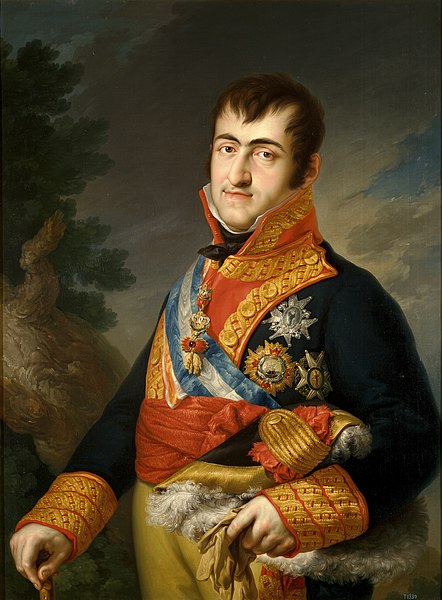Facts for Kids
Ferdinand VII was the King of Spain from 1808 to 1833, known for his battles between absolute monarchy and constitutional change.
Overview
Economic Challenges
Death And Succession
Constitutional Conflicts
Early Life And Education
Personal Life And Family
Restoration To The Throne
Reign And Political Context
Cultural And Artistic Influence
Involvement In The Peninsular War
Legacy And Historical Significance

Inside this Article
Charles Iv Of Spain
Constitution
Government
Napoleon
Portugal
Monarchy
Conflict
Austria
Spanish
People
Future
Did you know?
👑 Ferdinand VII was King of Spain from 1808 to 1833.
🎉 He was born on October 14, 1784, in Madrid, Spain.
⚔️ During his reign, Ferdinand faced wars and political challenges.
💔 Ferdinand was imprisoned by Napoleon when he invaded Spain in 1808.
🎨 He supported the arts, including famous artist Francisco Goya.
📜 Ferdinand rejected the 1812 constitution that gave rights to the people.
💰 Spain struggled with severe economic issues during his reign.
👶 He married four times and had a daughter named Isabella.
📖 His death in 1833 led to conflicts over the throne, known as the Carlist Wars.
✨ Ferdinand VII is remembered for the struggle between monarchy and democracy in Spain.
Introduction
He was born on October 14, 1784, in Madrid, the capital city of Spain. Although he faced many challenges during his reign, including wars and changing governments, he played a significant role in Spain's history. Ferdinand is often remembered for his struggle between absolute monarchy and constitutional government. 👑
His life was full of ups and downs, and he had a significant impact on many people in Spain and beyond!
Economic Challenges
The Peninsular War had destroyed many towns and disrupted trade. People were poor, and there were food shortages. Ferdinand tried to improve the economy by promoting agriculture and trade, but it was tough! The problem was that the royal treasury was empty. Many citizens felt the impact and struggled to make ends meet. This time was hard for Spain’s economy, making life difficult for families.
Death And Succession
After his death, his daughter Isabella took over as the queen. However, this led to conflicts between those who supported Isabella and those who wanted her uncle Carlota to be king. The disagreements caused a civil war called the Carlist Wars! Ferdinand’s death thus marked the beginning of a new chapter in Spanish history filled with conflict over the throne. 🎭
Constitutional Conflicts
️ In 1812, a constitution was written that gave more rights to the people. But when Ferdinand returned, he rejected it! This made many citizens upset. His refusal to accept changes led to rebellions and conflict within the country. Some people wanted freedom and democracy, while others liked how Ferdinand ruled. These ongoing struggles caused a lot of uncertainty and unrest in Spain.
Early Life And Education
As a child, he was raised in the royal palace in Madrid, where he had lessons from tutors. He learned about history, politics, and even military strategy. 🎓
Ferdinand was eager to learn about leadership, but he sometimes clashed with his father's ideas. By the time he became king, he had strong opinions about how to rule!
Personal Life And Family
He married four times! His first wife was Maria Antonia of Austria, but she died young. He later married two other women, and his fourth wife, Maria Cristina, helped him rule. 👶
Together, they had a daughter named Isabella, who became queen after Ferdinand's death. His family played important roles during his reign and afterwards, leaving a mark on Spain's future.
Restoration To The Throne
People celebrated because they wanted their king back! However, many hoped he would create a better government. Ferdinand was not as open to change as they had hoped. Instead of accepting the new ideas from the people, he wanted to rule like an absolute monarch. This caused tension in Spain as many continued to fight for a constitutional monarchy, which allowed the people to have a say in their government.
Reign And Political Context
️ In 1808, he was forced to give up the throne to Napoleon Bonaparte, a powerful French leader. This made many people unhappy. After several years and wars, he returned to the throne in 1814. But changes in the government made things complicated! Some people wanted a democracy, while others wanted to keep the monarchy strong. This fight for power greatly affected Spain in the early 19th century.
Cultural And Artistic Influence
During his reign, architecture and painting boomed! Famous artists like Francisco Goya created works reflecting Spanish life. Goya painted both beautiful scenes and darker images of war. 🏛
️ Ferdinand also built monuments and palaces, which still stand today! His love for culture helped create a unique Spanish identity during a challenging time. Art and history blended, showing the struggles and achievements of the people.
Involvement In The Peninsular War
The war was very tough for many, but it also helped spark feelings of nationalism among the Spanish people. After the war, Ferdinand regained his throne, but things had changed in Spain forever!
Legacy And Historical Significance
After his death, Spain transitioned through various political changes. His strong desire to maintain monarchy showed the struggles between traditional rule and modern democracy. Ferdinand’s time helped set the stage for future conflicts and constitutional changes in Spain. His legacy reminds us that leadership can be challenging and has lasting effects on a country's path.

